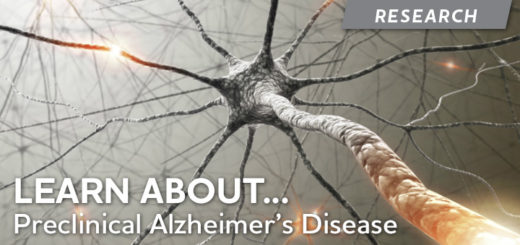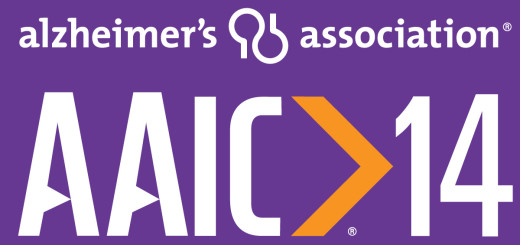What if there was a test that would tell you if you’re going to get Alzheimer’s?
 If there was a test that could diagnose Alzheimer’s before the onset of symptoms, would you take it? Most people indicate they’d rather not know.
If there was a test that could diagnose Alzheimer’s before the onset of symptoms, would you take it? Most people indicate they’d rather not know.
But what if we could intervene in the earliest stages of the disease, before irreversible brain damage or mental decline occurs? Most of us would readily agree to tests. Alzheimer’s scientists are working on making that dream a reality. In the future, we are likely to move from treating progressive dementia towards early identification and treatment of Alzheimer’s disease before any symptoms occur.
A critical factor in early detection of Alzheimer’s is identifying biomarkers. Biomarkers are reliable predictors and indicators of a disease process. For example, high cholesterol is a trusted indicator for coronary heart disease. It is now accepted medical practice to monitor cholesterol and consider heart-healthy lifestyle changes or medications when blood levels exceed 200 mg/dL, before a person develops active symptoms of heart disease.
While there are currently no validated biomarkers for Alzheimer’s disease, researchers are investigating several promising candidates, including observing protein changes or brain damage via brain imaging, proteins in cerebrospinal fluid and in blood and genetic risk profiling:
Brain imaging
What it is: PET scans, MRI, fMRI, SPECT and other methods of imaging may be able to detect hallmark changes associated with Alzheimer’s disease in the brains of living individuals. In many instances brain scans help verify a diagnosis and rule out other potential causes.
Challenges: Unfortunately brain imaging results alone are sometimes not as clear cut as you might think. False positives occur relatively frequently. In some instances, individuals with no signs of cognitive decline may have a brain full of amyloid protein – the protein of which the plaques that are associated with Alzheimer’s are made. Using the brain scan alone, these individuals might be mislabeled as having Alzheimer’s.
Current research: The Alzheimer’s Disease Neuroimaging Initiative (ADNI), a nationwide study launched by the National Institute on Aging (NIA) and supported by the Alzheimer’s Association is establishing standards for obtaining and interpreting brain images and biological samples. Its ultimate goal is to determine whether standardized imaging protocols, possibly combined with laboratory and psychological tests, may offer a better way to identify high-risk individuals, provide earlier diagnosis, track disease progression and monitor treatment effects, especially in clinical trials of disease-modifying drugs.
Spinal tap tests
What it is: Cerebrospinal fluid (CSF) is a clear fluid that bathes and cushions the brain and spinal cord. Research suggests that Alzheimer’s disease in its earliest stages may cause changes in CSF levels of tau and beta-amyloid, two proteins that form abnormal brain deposits strongly linked to the disease.
Challenges: One challenge yet to be resolved is that analysis of protein levels in the same sample often varies significantly from institution to institution. This is a very promising approach to early identification but, because of the need for an invasive test (a spinal tap), may not be practical in routine screenings.
Current research: Researchers continue to work on developing these very promising CSF tests. Additionally, the Alzheimer’s Association has funded the Alzheimer’s Association QC Program for CSF Biomarkers, to create consistency in analyzing Alzheimer-related CSF proteins. This provides a means for organizations to compare their sample analysis outcomes to results at reference laboratories in the United States and Europe.
Blood-based testing
What it is: Researchers are paying particular attention to whether pre-symptomatic Alzheimer’s disease causes consistent, measurable changes in urine or blood levels of tau, beta-amyloid or other biomarkers.
Challenges: While some of these possible biomarkers have been in the news lately, none have been validated quite yet.
Current research: In April 2012, the Alzheimer’s Association and the Alzheimer’s Drug Discovery Foundation convened top scientists from around the world to discuss the state of blood based biomarker development. Conclusions from the study found that, while blood-based biomarkers are currently considered the “holy grail of early detection” in Alzheimer’s disease, they do not yet provide valid diagnostic information.
Genetic risk profiling
What it is: A genetic mutation is an abnormal change in the sequence of chemical pairs that make up genes. A small percentage of Alzheimer’s cases – an estimated one percent or less – develop as a result of three genetic mutations that are known to cause the disease. Scientists have also identified several genes that increase risk but don’t guarantee that a person will develop the disease.
Challenges: Testing to detect the three rare genetic mutations that cause Alzheimer’s can help show whether an individual family member carries the gene mutation and eventually develop Alzheimer’s. However, current test to identify the genes that increase risk of the disease are just that – tests that show an increase risk of Alzheimer’s, but not a guarantee that the disease will develop. Because no treatments are currently available to prevent, slow or stop Alzheimer’s disease, results of these tests may have major impact on emotions, employment status, health insurance, long-term care insurance and future plans.
Current research: Investigators worldwide are working to find additional risk genes. The Alzheimer’s Association partnered with the National Institute on Aging (NIA) to recruit participants for the National Alzheimer’s Disease Genetics Study, a landmark initiative launched to clarify genes involved in late-onset Alzheimer’s by creating a privacy-protected database of blood samples and family information.
Of all areas of Alzheimer’s research, early identification of the disease is making consistent gains. While we can debate our own personal and ethical perspectives on the benefit and risks of early identification, we can probably agree on one thing: We need to find people early in the disease and intervene effectively. It is my hope that within five years we will have accomplished this first task of early identification. Once that is done, we have the potential to ward off dementia before it occurs. What a wonderful world that would be: a world without Alzheimer’s.
Helpful information related to this story:
The Alzheimer’s Association Research Center
Video: The Quest for Biomarkers


















That type of test coupled with an improved ability to combat the disease at an earlier stage would be a major development in neurological research, and one that I hope we won’t have to wait long for. Personally, this horrible disease has affected my family, and I can understand why many would be reluctant to take a test which may only tell them that they are at greater risk. I also completely agree with your assessment of the need for early detection, thank you.
I would take the test, but only if I could remain anonymous. I do not trust that I will always be able to get insurance and don’t want any more strikes against me than I already have.
Please touch on retinal scans to detect amyloid plaques